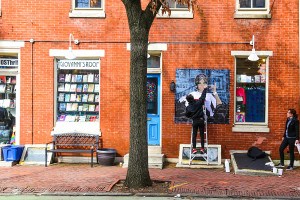Pulse: Atlantic City Journal: Sign Language
Lights say a lot about a town, and for the past 30 years, the message of the red neon haze that greets visitors on the Atlantic City Expressway has roughly been:
You are now entering Hell.
TRUMP. TROPICANA. BALLY’S. TRUMP MARINA. TRUMP TAJ MAHAL. RESORTS. CA$H FOR GOLD. And, in a slightly edgier font, CAESARS.
“The majority of the rest of the buildings in this town are white boxes with red neon,” Robert Boughner, the departing Borgata CEO, told the New York Times with a sneer when he opened the city’s one non-red building, the purple-and-gold mega-luxe casino.
Red neon is the cheapest kind. It serves a purpose. It does not say: We want you to ooh and ahh and traipse around town admiring us. It says: We exist. We exist for you to park and come quickly inside and fill a plastic bucket with tokens right away.
A.C. folks don’t pay much attention to what goes on outside. On a recent tour around town in broad daylight, Susan Ricciardi of the Atlantic City Convention and Visitors Authority confessed to me that she “didn’t even notice” the pawnshops and boarded-up houses just off the Boardwalk anymore — so many eye-pleasing developments were happening inside casinos. As befits an inward-looking town, Atlantic City began its extreme makeover largely from the interior: renovating its poker rooms, adding swanky restaurants, staffing its cocktail lounges with ever-fairer young waitresses.
But a division of Clear Channel known as Spectacolor plans to change all this. Spectacolor, which is best known for the three-dimensional video screen billboards (they’re actually called “spectaculars” in the billboard industry) that epitomize the transformation of Times Square, has the outdoor advertising contract for the Pier at Caesars, a vast, glass-walled $175 million luxury mall due to open in May right on the Atlantic City Boardwalk. Spectacolor CEO Mike Forte eventually sees on the Boardwalk something similar to Victoria Harbour, the neon-and-LED barrage that greets spectators on the China side of Hong Kong Island. He sees Shibuya in Japan. He sees the Atlantic City of the 1920s, when the fanciest, newest-fangled neon-accented billboards of the time advertised Lucky Strike cigarettes and Horlick’s Malted Milk to the legions of blazer-and-hat-clad Boardwalk-goers below.
In other words, he sees not just state-of-the-art advertising, but a crowd of visitors who deserve to have things advertised to them. And this may be the most powerful sign (hah!) yet that Atlantic City is changing. Five years ago, when most Boardwalkers were senior citizens, vinyl billboards stood empty: ADVERTISE HERE, CALL (609) 555-5555. This is because no one wants to advertise things to senior citizens, whose purchasing patterns are already well established (and who will stop purchasing altogether soon enough). But according to Forte, the demographics for Atlantic City these days are “actually better” — that is, younger — than those of Vegas (average age in A.C. is 47, compared with 48 in Vegas). And with the rise of TiVo and TiVoesque devices capable of blurring through TV advertisements, the attention — the eyeballs — of those Boardwalk-goers is very attractive to advertisers.
Forte is trying to sell big clients on all this. It will take at least a year of solid performance, he says, before any “spectaculars” go up at Caesars; the interactive Times Square-style billboards cost as much as $3.5 million simply to construct. But, he adds, “a retailer who’s a client with a signature colored box” (a luxury jeweler immortalized by Truman Capote, perhaps?) is signing on to do a “really innovative” gift-box-shaped billboard, replete with neon accents and huge “ribbons.” He promises the many billboards will be brightly lit, and incorporate the sort of video and neon and flashbulb elements that say to visitors, “We want your eyeballs.”


